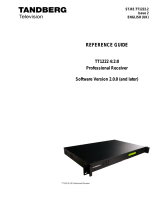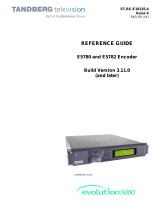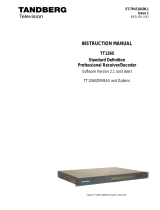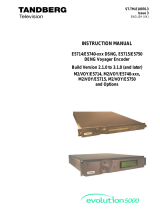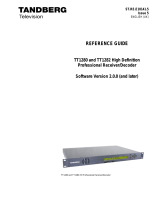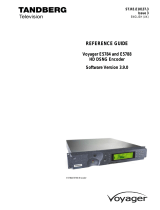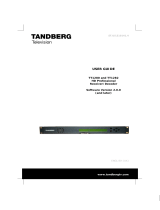Page is loading ...

ST.RE.E10233.1
Issue 1
REFERENCE GUIDE
EN8000
MPEG-4 Part 10 (H.264/AVC)
Encoders
Software Version 1.0 (and later)
EN8030 Standard Definition Encode
r
EN8090 High Definition Encode
r

Preliminary Pages
Page ii Reference Guide: EN8000 MPEG-4 Part 10 (H.264/AVC) Encoders
ST.RE.E10233.1
Issue 1 first published in 2007 by:
T
ANDBERG TELEVISION LTD
R
EGISTERED ADDRESS:
UNIT 2 STRATEGIC PARK, COMINES WAY,
H
EDGE END, SOUTHAMPTON,
HAMPSHIRE,
SO30 4DA
U
NITED KINGDOM
Registered Company Number 03695535
This document and the information contained in it is the
property of TANDBERG Television Ltd and may be the
subject of patents pending and granted. It must not be
used for commercial purposes nor copied, disclosed,
reproduced, stored in a retrieval system or transmitted
in any form or by any means (electronic, mechanical,
photocopying, recording or otherwise), whether in
whole or in part, without TANDBERG Television’s prior
written agreement.
©
2007 TANDBERG Television Ltd.
All rights reserved.
SVENSKA
LÄS DETTA FÖRST!
Om Ni inte förstår informationen i denna handbok
ARBETA DÅ INTE MED DENNA UTRUSTNING.
En översättning till detta språk av denna handbok kan också anskaffas,
på Er bekostnad.
ENGLISH (UK)
READ THIS FIRST!
If you do not understand the contents of this manual
DO NOT OPERATE THIS EQUIPMENT.
Also, translation into any EC official language of this manual can be
made available, at your cost.
ΕΛΛΗΝΙΚΑ
∆ΙΑΒΑΣΤΕ ΠΡΩΤΑ ΑΥΤΟ!
Αν δεν καταλάβετε το περιεχόµενο αυτού του βοηθήµατος/εγχειριδίου
ΜΗΝ ΛΕΙΤΟΥΡΓΗΣΕΤΕ ΑΥΤΟΝ ΤΟΝ ΕΞΟΠΛΙΣΜΟ.
Επίσης, αυτό το εγχειρίδιο είναι διαθέσιµο σε µετάφραση
σε αυτή τη γλώσσα και µπορείτε να το αγοράσετε.
DEUTSCH
LESEN SIE ZUERST DIESEN HINWEIS!
Sollte Ihnen der Inhalf dieses Handbuches nicht klar verständlich sein,
dann
BEDIENEN SIE DIESE GERÄTE NICHT!
Eine Übersetzung des Handbuches in diese Sprache ist gegen
Berechnun
g
lieferbar.
ESPAÑOL
LEA ESTE AVISO PRIMERO!
Si no entiende el contenido de este manual
NO OPERE ESTE EQUIPO.
Podemos asimismo suministrarle una traducción de este manual al
(idioma) previo pago de una cantidad adicional que deberá abonar
usted mismo.
FRANÇAIS
AVANT TOUT, LISEZ CE QUI SUIT!
Si vous ne comprenez pas les instructions contenues dans ce manuel
NE FAITES PAS FONCTIONNER CET APPAREIL.
En outre, nous pouvons vous proposer, à vos frais, une version
française de ce manuel.
ITALIANO
LEGGERE QUESTO AVVISO PER PRIMO!
Se non si capisce il contenuto del presente manuale
NON UTILIZZARE L’APPARECCHIATURA.
È anche disponibile la versione italiana di questo manuale, ma il costo è
a carico dell’utente.
PORTUGUÊS
LEIA O TEXTO ABAIXO ANTES DE MAIS NADA!
Se não compreende o texto deste manual
NÃO UTILIZE O EQUIPAMENTO.
O utilizador poderá também obter uma tradução do manual para o
português à própria custa.
NEDERLANDS
LEES DIT EERST!
Als u de inhoud van deze handleiding niet begrijpt
STEL DEZE APPARATUUR DAN NIET IN WERKING.
U kunt tevens, op eigen kosten, een vertaling van deze handleiding
krijgen.
DANSK
LÆS DETTE FØRST!
Udstyret må ikke betjenes
MEDMINDRE DE TIL FULDE FORSTÅR INDHOLDET AF DENNE
HÅNDBOG.
Vi kan også for Deres regning levere en dansk oversættelse af denne
håndbog.
SUOMI
LUE ENNEN KÄYTTÖÄ!
Jos et ymmärrä käsikirjan sisältöä
ÄLÄ KÄYTÄ LAITETTA.
Käsikirja voidaan myös suomentaa asiakkaan kustannuksella.

Preliminary Pages
Reference Guide: EN8000 MPEG-4 Part 10 (H.264/AVC) Encoders Page iii
ST.RE.E10233.1
List of Contents
Chapter 1: Introduction to the Basic Encoder
This chapter gives a general description of the equipment and its main features and functions.
Identifies the controls, indicators and connectors on the front and rear panels.
Chapter 2: Installing the Equipment
This chapter provides a guide to the suitability of an installation and gives detailed procedures
for the preparation and installation of the equipment. Also details the external connectors and
provides important safety information.
Chapter 3: Options and Upgrades
This chapter describes the options and upgrades available for the EN8000 Encoder models.
Chapter 4: Operating the Equipment Locally
This chapter describes local control in detail. Provides the power-up/-down procedures and
other general operating/control/set-up procedures.
Chapter 5: Web Browser Interface
This chapter details how to access and use the Web Browser Interface for a range of
diagnostic and other utilities.
Chapter 6: Picture in Picture
Describes the operation and use of the Picture in Picture function. The software option
EN8000/SWO/PIP is required to enable this operation.
Chapter 7: Preventive Maintenance and Fault-finding
This chapter details routine maintenance tasks to be performed by the operator and provides
general servicing advice and fault-finding information. Provides information regarding warranty
and maintenance available from Customer Services. Gives relevant disposal information.
Annex A: Glossary
Annex B: Technical Specification
Annex C: Language Abbreviations
Annex D: Creating and Downloading a Logo
Annex E: Audio Modes
Annex F: Accuracy of Frequency Sources

Preliminary Pages
Page iv Reference Guide: EN8000 MPEG-4 Part 10 (H.264/AVC) Encoders
ST.RE.E10233.1
About this Reference Guide
This Reference Guide provides instructions and information for the installation and operation
of the EN8000 Encoder range.
This Reference Guide should be kept in a safe place for reference for the life of the
equipment. It is not intended that this Reference Guide will be amended using the issue of
individual pages. Any revision will be by a complete reissue. Further copies of this Reference
Guide can be ordered from the address shown on page viii. If passing the equipment to a third
party, also pass on the relevant documentation.
Issues of this Reference Guide are listed below:
Issue Date Software Version Comments
1 Mar 2007 1.0 Initial release.
The following manuals are also associated with this equipment:
• ST.US.E10233: User Guide for EN8030
• ST.US.E10234: User Guide for EN8090
• ST.AN.E10074: Upgrade Wizard
• ST.AN.1094: Video Noise Reduction and Compression
• ST.AN.1097: VBI in TANDBERG Television Systems
Nomenclature
The terms RS-232 and RS-422 have been superseded by EIA-232 and EIA-422. However,
because the original names are inscribed on the Encoder the original terms are used in the
text of this Reference Guide.

Preliminary Pages
Reference Guide: EN8000 MPEG-4 Part 10 (H.264/AVC) Encoders Page v
ST.RE.E10233.1
Acknowledgements
General
All best endeavours have been made to acknowledge registered trademarks and trademarks
used throughout this manual. Any notified omissions will be rectified in the next issue of this
manual. Some trademarks may be registered in some jurisdictions but not in others.
Registered trademarks and trademarks used are acknowledged below and marked with their
respective symbols. However, they are not marked within the text of this Reference Guide.
Registered Trademarks
AC-3
®
, Dolby Digital
®
and Pro Logic
®
are registered trademarks of Dolby Laboratories
Licensing Corporation.
Musicam
®
is a registered trademark of Thomson and Télédiffusion de France (TDF), Europe,
and is a registered trademark of CCS (now Musicam USA Incorporated), USA.
Ethernet
®
is a registered trademark of Xerox Corporation.
XILINX
®
is a registered trademark of Xilinx Inc.
Trademarks
AAC™ is a trademark of Fraunhofer IIS.
NDS™ is a trademark of NDS Limited.
Pozidriv™ is a trademark of European Industrial Services.
Reflex™ is a trademark of TANDBERG Television.
SBR™, Spectral Band Replication™ and aacPlus™ are trademarks of Coding Technologies.
STREAMS™ is a trademark of TANDBERG Television.
WindowsMedia™ is a trademark of Microsoft Corporation.

Preliminary Pages
Page vi Reference Guide: EN8000 MPEG-4 Part 10 (H.264/AVC) Encoders
ST.RE.E10233.1
Warnings, Cautions and Notes
Heed Warnings
All warnings on the product and in the operating instructions should be adhered to. The
manufacturer cannot be held responsible for injuries or damage where warnings and cautions
have been ignored or taken lightly.
Read Instructions
All the safety and operating instructions should be read before this product is operated.
Follow Instructions
All operating and use instructions should be followed.
Retain Instructions
The safety and operating instructions should be retained for future reference.
WARNINGS...
WARNINGS GIVE INFORMATION WHICH, IF STRICTLY OBSERVED, WILL PREVENT PERSONAL
INJURY OR DEATH, OR DAMAGE TO PERSONAL PROPERTY OR THE ENVIRONMENT. THEY
ARE BOXED AND SHADED FOR EMPHASIS, AS IN THIS EXAMPLE, AND ARE PLACED
IMMEDIATELY PRECEDING THE POINT AT WHICH THE READER REQUIRES THEM.
CAUTIONS...
Cautions give information which, if strictly followed, will prevent damage to equipment or other goods.
They are boxed for emphasis, as in this example, and are placed immediately preceding the point at
which the reader requires them.
NOTES...
Notes provide supplementary information. They are highlighted for emphasis, as in this example, and
are placed immediately after the relevant text.
EMC Compliance
This equipment is certified to the EMC requirements detailed in Annex B, Technical
Specification. To maintain this certification, only use the leads supplied or if in doubt contact
Customer Services.

Preliminary Pages
Reference Guide: EN8000 MPEG-4 Part 10 (H.264/AVC) Encoders Page vii
ST.RE.E10233.1
Contact Information
TANDBERG Television Customer Services
Support Services
Our primary objective is to provide first class customer care that is tailored to your specific
business and operational requirements. All levels are supported by one or more service
performance reviews to ensure the perfect partnership between TANDBERG Television and
your business.
Warranty
All TANDBERG Products and Systems are designed and built to the highest standards and
are covered under a comprehensive 12 month warranty.
Levels of Continuing TANDBERG Television Service Support
For stand-alone equipment, then TANDBERG Television Basic Advantage is the value for
money choice for you.
Basic provides you with year-by-year Service long after the warranty has
expired.
For systems support you can choose either Gold or Silver Advantage. These packages are
designed to save you costs and protect your income through enlisting the help of TANDBERG
Television support specialists.
VOYAGER Advantage is the truly mobile service solution. This provides a package
specifically designed to keep you mobile and operational.
Call TANDBERG Sales for more details.
Where to Find Us
Europe, Middle East +44 (0) 23 8048 4455
and Africa: Fax: +44 (0) 23 8048 4467
Americas: +888 671 1268 (US and Canada)
+678 812 6255 (Outside of mainland US)
China: +86 10 6856 0260 (Beijing)
+852 2530 3215 (Hong Kong)
fieldservice-asia@tandbergtv.com
Australia/NZ: +612 8923 0450
fieldservice-australia@tandbergtv.com
Internet Address: http://www.tandbergtv.com

Preliminary Pages
Page viii Reference Guide: EN8000 MPEG-4 Part 10 (H.264/AVC) Encoders
ST.RE.E10233.1
Technical Training
Training Courses
TANDBERG Television provides a wide range of training courses on the operation and
maintenance of our products and on their supporting technologies. TANDBERG can provide
both regularly scheduled courses and training tailored to individual needs. Courses can be run
either at your premises or at one of our dedicated training facilities.
Where to Find Us
For further information on TANDBERG Television's training programme please contact us:
International Telephone: +44 23 8048 4229
International Facsimile +44 23 8048 4467
E-mail Address: training@tandbergtv.com
Internet Address http://www.tandbergtv.com
Customer Services and Technical Training Postal Address
Tandberg Television
Unit 2
Strategic Park
Comines Way
Hedge End
Southampton
Hampshire
SO30 4DA
United Kingdom
Return of Equipment
If you need to return equipment for repair, please contact the Customer Services Helpdesk on
+44 (0) 23 8048 4455. A Returns Authorisation Number (RAN) will be issued and full details of
the unit will be logged. Please ensure the RAN number is clearly marked on the packaging of
the unit. The unit should then be sent to the following address:
Tandberg Television – Customer Services
Unit 1
Strategic Park
Comines Way
Hedge End
Southampton
Hampshire
SO30 4DA
United Kingdom
Technical Publications
If you need to contact TANDBERG Television Technical Publications regarding this
publication, e-mail: techpubs@tandbergtv.com.

Reference Guide: EN8000 MPEG-4 Part 10 (H.264/AVC) Encoders Page 1-1
ST.RE.E10233.1
Chapter 1
1. Introduction to the Basic Encoder
Contents
1.1 Scope of this Reference Guide .........................1-3
1.1.1 Who Should Use This Reference
Guide.....................................................1-3
1.1.2 Software Version ...................................1-3
1.1.3 What Equipment is Covered by This
Reference Guide....................................1-3
1.1.4 Optional Features ..................................1-4
1.1.5 Service Availability.................................1-4
1.2 Modes of operation ...........................................1-4
1.2.1 MPEG-4/H.264 AVC over TS.................1-4
1.2.2 Picture-in-Picture ...................................1-4
1.3 Video Encoding.................................................1-5
1.3.1 SD Video Inputs (EN8030 Encoder) ......1-5
Video Input Types..................................1-5
Serial Digital Video Input Error
Detection and Handling (EDH)...............1-5
Video Pre-processing.............................1-5
Internal Frame Synchroniser..................1-5
Output on Video Loss ............................1-6
1.3.2 HD Video Input (EN8090 Encoder)........1-6
Video Input Types..................................1-6
Video Pre-processing.............................1-6
Downsampler.........................................1-7
Internal Frame Synchroniser..................1-7
Output on Video Loss ............................1-7
1.3.3 Video Encoding......................................1-7
H.264/AVC Encoding.............................1-7
1.4 Audio Encoding.................................................1-8
1.4.1 Audio Inputs (EN8090 HD Encoder)......1-8
Audio Channels .....................................1-8
Output on Digital Audio Loss .................1-8
Test Tones.............................................1-8
1.4.2 Audio Inputs (EN8030 SD Encoder) ......1-9
Audio Channels .....................................1-9
Output on Digital Audio Loss .................1-9
Test Tones.............................................1-9
1.4.3 Audio Encoding....................................1-10
AAC (MPEG-2 and MPEG-4)...............1-10
MPEG-1 Layer II ..................................1-10
Dolby Digital.........................................1-11
Pass-thru..............................................1-11
1.5 VBI Line Processing Modes ............................1-11
Transport of VBI Data ..........................1-11
Teletext Extraction ...............................1-12
1.6 Guided Tour ....................................................1-12
1.6.1 Enclosure.............................................1-12
1.6.2 Front Panel Description........................1-12
1.6.3 Rear Panel Description........................1-13
List of Figures
Figure 1.1: EN8030 Encoder Front View.............................. 1-3
Figure 1.2: Front Panel Indicators ......................................1-13
List of Tables
Table 1.1: Equipment Model Descriptions............................ 1-3
Table 1.2: Encapsulation Mode ............................................ 1-4
Table 1.3: Supported High Definition Scanning Modes........ 1-6
Table 1.4: Supported VBI Data Formats.............................1-12
Table 1.5: Front Panel Indicators........................................ 1-12

Introduction to the Basic Encoder
Page 1-2 Reference Guide: EN8000 MPEG-4 Part 10 (H.264/AVC) Encoders
ST.RE.E10233.1
BLANK

Introduction to the Basic Encoder
Reference Guide: EN8000 MPEG-4 Part 10 (H.264/AVC) Encoders Page 1-3
ST.RE.E10233.1
1.1 Scope of this Reference Guide
1.1.1 Who Should Use This Reference Guide
This Reference Guide is written for operators/users of the EN8000 Range of Encoders to
assist in the installation, operation and day-to-day care. The range currently consists of the
EN8030 Standard Definition Encoder for MPEG-4 Part 10 and the EN8090 High Definition
Encoder for MPEG-4 Part 10.
WARNING…
DO NOT REMOVE THE COVERS OF THIS EQUIPMENT. HAZARDOUS VOLTAGES ARE PRESENT
WITHIN THIS EQUIPMENT AND MAY BE EXPOSED IF THE COVERS ARE REMOVED. ONLY
TANDBERG TELEVISION TRAINED AND APPROVED SERVICE ENGINEERS ARE PERMITTED TO
SERVICE THIS EQUIPMENT.
CAUTION…
Unauthorized maintenance or the use of non-approved replacements may affect the equipment
specification and invalidate any warranties.
This Reference Guide does not include any maintenance information or procedures that would
require the removal of covers. This Guide focuses on operating the Encoder via the Web
browser and highlights some specific aspects of the Front Panel control. It does not cover the
Engineering menu or the use of a Telnet session.
1.1.2 Software Version
This version of the Reference Guide has been written to cover the functionality in software
version 1.0 for the EN8030 Encoder and software version 1.0 for the EN8090 Encoder.
1.1.3 What Equipment is Covered by This Reference Guide
Figure 1.1: EN8030 Encoder Front View
Table 1.1: Equipment Model Descriptions
Model Number Marketing Code Description
EN8030 SD Encoder EN8030/BAS
1RU Encoder implementing Standard Definition H.264/AVC Main
Profile video and MPEG audio encoding. Includes transport stream
output capability and IP/Ethernet output.
EN8030 SD Encoder
(-48 Vdc version)
EN8030/BAS/48V EN8030/BAS Encoder with –48 Vdc input
EN8090 HD Encoder EN8090/BAS
1RU Encoder implementing High Definition H.264/AVC Main Profile
video and MPEG audio encoding. Includes transport stream output
capability and IP/Ethernet output.
EN8090 HD Encoder
(-48 Vdc version)
EN8090/BAS/48V EN8090/BAS Encoder with –48 Vdc input
Since this Reference Guide covers both the EN8030 and EN8090, it provides information
covering both SD and HD operation.

Introduction to the Basic Encoder
Page 1-4 Reference Guide: EN8000 MPEG-4 Part 10 (H.264/AVC) Encoders
ST.RE.E10233.1
1.1.4 Optional Features
This guide is intended to cover all features and functions of the unit. However some of these
features may be purchasable options or features that have not been included in this release. If
in doubt, please contact TANDBERG Television Customer Services for clarification.
1.1.5 Service Availability
The EN8030 Encoder is able to generate an MPEG-4 Standard Definition output and the
EN8090 Encoder is able to generate an MPEG-4 High Definition output or an MPEG-4
Standard Definition output.
1.2 Modes of operation
1.2.1 MPEG-4/H.264 AVC over TS
The elementary streams from the EN8000 H.264/AVC encoding module are encapsulated into
an MPEG TS (Transport Stream) system within the Encoder.
• Video: Main and High Profile of the ISO/IEC 14496-10 (H.264/AVC) technology are
supported.
• Audio: There is a wide range of audio encoding standards that can be used including
MPEG-1 Layer II and Dolby Digital.
• Output: The elementary streams from the Intelligent Compression Engine (ICE) card are
multiplexed on the motherboard of the Encoder into a compliant single-program transport
stream. Hence, the combined output of these streams is through the ASI outputs on the
motherboard.
• Option: An IP/Ethernet output card (EN8000/HWO/IPTSDUAL) can be fitted to the
EN8000 range of encoders to allow the transmission of TS over IP using RFC 2250.
The details of this are shown in Table 1.2.
Table 1.2: Encapsulation Mode
Mode MPEG-4 AVC over TS
Where used EN8030, EN8090
Video H.264/AVC Main and High Profile
Audio MPEG-1 Layer II audio, Dolby Digital, linear, MPEG-2 AAC, MPEG-4 HE-AAC, MPEG-4 HE-AAC v2
Output
TS outputs on the Encoder: the standard is ASI output but this can extend to IP using the IP/Ethernet
output option card.
1.2.2 Picture-in-Picture
If the software option EN8000/SWO/PIP is purchased for the Encoder, there is the capability
of generating a second, reduced resolution, video image. The Encoder produces a multiple
program transport stream (MPTS) where one service is the broadcast stream and the other
contains the reduced resolution video image. This is covered in more detail in Chapter 3,
Options and Upgrades and Chapter 6, Picture in Picture.

Introduction to the Basic Encoder
Reference Guide: EN8000 MPEG-4 Part 10 (H.264/AVC) Encoders Page 1-5
ST.RE.E10233.1
1.3 Video Encoding
1.3.1 SD Video Inputs (EN8030 Encoder)
The standard video inputs are:
• SDI - Serial Digital Interface - ITU-R BT.656-4, part 3 (D1 serial format) – SMPTE 259
(component only)
• Composite Analogue (PAL/NTSC)
Video Input Types
The video input types, which are supported, are:
• 625-line composite PAL-B, -D, -G, -H or -I (ITU-R BT. 624-4)
• 525-line composite NTSC-M (with and without pedestal) or PAL-M (ITU-R BT. 624-4)
• Serial digital (ITU-R BT.656-4, part 3) input (D1 serial format) and (ANSI/SMPTE 259M)
(component only)
• Internal test pattern function
Serial Digital Video Input Error Detection and Handling (EDH)
The serial digital video input supports error detection and handling (EDH) as defined by the
specification SMPTE RP 165-1994, ‘Error Detection Checkwords and Status Flags for Use in
Bit Serial Digital Interfaces for Television’.
Video Pre-processing
The efficiency of the encoding can be enhanced through pre-processing of the incoming video
using functions such as:
• Support for different resolutions including the standard set of video picture resolutions
(720, 704, 640, 576, 544, 528, 480, 352) in both 625 and 525 line operation.
• An internal frame synchroniser.
• The aspect ratio for the incoming video feed as defined in the VBI, can be maintained in
the output if desired.
• Generation of test patterns to allow the overall system to be tested.
• Replacement of the video stream when input is lost.
• Built-in patented adaptive noise reduction circuitry
1
.
• When the SD-SDI input is used, a logo overlay facility is available whereby the Encoder is
configured to overlay a broadcaster’s trademark/logo onto the active video.
Internal Frame Synchroniser
An internal frame synchronizer is provided to accommodate slight differences between the
incoming frame rate and that generated by the stable reference
2
used by the Encoder.
1
Noise reduction is only available when software option EN5900/SWO/NR is purchased.
2
To ensure broadcast quality it is recommended that the studio reference is fed to HYSNC.

Introduction to the Basic Encoder
Page 1-6 Reference Guide: EN8000 MPEG-4 Part 10 (H.264/AVC) Encoders
ST.RE.E10233.1
Output on Video Loss
In the event of video input loss the Encoder can be software-configured to show either:
• A test pattern (with or without identification text).
• A freeze frame (with or without identification text).
• Cut to a black screen (with or without identification text).
• Drop the video PID if TS encapsulation is active.
1.3.2 HD Video Input (EN8090 Encoder)
The only operational video input is:
• HD-SDI (so named on the back panel) - High Definition Serial Digital Interface that is
compliant to SMPTE 292M.
Video Input Types
The video input frame rate and resolution is user selectable and the available options are
shown in Table 1.3.
Table 1.3: Supported High Definition Scanning Modes
Resolution (V x H) P / I Frame rate Carried as: Standard
720 x 1280 Progressive 50.00 frame/s Native SMPTE296M
720 x 1280 Progressive 59.94 frame/s Native SMPTE296M
1080 x 1920 Interlaced 25.00 frame/s Native SMPTE274M
1080 x 1920 Interlaced 29.97 frame/s Native SMPTE274M
Video Pre-processing
The efficiency of the encoding can be enhanced through pre-processing of the incoming video
using functions such as:
• Support for reduced horizontal resolution on the encoded video relative to the input video
to reduce the macro-block rate such as resizing from 1920 pixels to 960 pixels for 1080-
line resolution and resizing from 1280 pixels to 640 pixels for 720-line resolution.
• A downsampler.
• An internal frame synchroniser.
• The aspect ratio for the incoming video feed as defined in the VBI, can be maintained in
the output if desired.
• Generation of test patterns to allow the overall system to be tested.
• Replacement of the video stream when input is lost.
• Built-in patented adaptive noise reduction circuitry
3
.
3
Noise reduction is only available when software option EN8000/SWO/NR is purchased.

Introduction to the Basic Encoder
Reference Guide: EN8000 MPEG-4 Part 10 (H.264/AVC) Encoders Page 1-7
ST.RE.E10233.1
Downsampler
NOTE…
Availability of this option requires the EN8000/SWO/PIP licence.
A downsampler is implemented for the HD-SDI input. The output of the downsampler is either:
• 720 x 480 @ 29.97 frame/s for input frame rate of 29.97 or 59.94 frame/s
• 720 x 576 @ 25 frame/s for input frame rate of 25 or 50 frame/s.
Internal Frame Synchroniser
An internal frame synchronizer is provided to accommodate slight differences between the
incoming frame rate and that generated by the stable reference
4
used by the Encoder.
Output on Video Loss
In the event of video input loss the Encoder can be software-configured to show either:
• A test pattern (with or without identification text).
• A freeze frame (with or without identification text).
• Cut to a black screen (with or without identification text).
1.3.3 Video Encoding
H.264/AVC Encoding
Both the EN8030 and EN8090 Encoders can generate a bitstream, from the input video, that
is compliant with the MPEG-4 Part 10 (ISO/IEC 14496-10) specification with a maximum
bitrate of 10.0 Mbit/s for SD operation and 20.0 Mbit/s for HD operation. The H.264/AVC video
encoding functions include.
• Support for the following tools
Spatial Intra prediction: Intra macro-blocks are predicted from surrounding,
previously coded macro-blocks.
Sub-pixel motion vectors: This allows motion to be more accurately represented.
CABAC: Context Adaptive Binary Arithmetic Coding – a more efficient form of
entropy coding compared to traditional variable length codes.
Adaptive GOP structures of IP, IBP, IBBP and IBBBP where the encoder chooses
whether to use B frames according to the video content.
• Selectable bitrate operation:
SD = 0.256 Mbit/s – 10.000 Mbit/s.
HD = 1.000 Mbit/s – 20.000 Mbit/s
• Support for horizontal resizing of the input image such as resizing from 1920 pixels to 960
pixels for 1080-line resolution and resizing from 1280 pixels to 640 pixels for 720-line
resolution.
• Support for variable GOP lengths of up to 250 frames with I frame insertion at scene cuts
to optimise encoding efficiency.
• The decoder buffer can be varied between 0.3 second for low delay applications to 3.0
seconds for premium quality.
4
To ensure broadcast quality it is recommended that the studio reference is fed to HYSNC.

Introduction to the Basic Encoder
Page 1-8 Reference Guide: EN8000 MPEG-4 Part 10 (H.264/AVC) Encoders
ST.RE.E10233.1
1.4 Audio Encoding
1.4.1 Audio Inputs (EN8090 HD Encoder)
The standard audio inputs are:
• AUDIO IN 2 - This 15-way male D-type connector can be used for the input of up to four
stereo pairs of AES/EBU digital audio when the optional audio encoding daughter card
(EN8000/HDC/AUD) is fitted. Only the input sampling rate of 48 kHz is supported. A
break-out cable is supplied which plugs into this connector and provides a more
convenient means of connecting the audio inputs via five connectors. There are four XLR
female connectors, with the fifth cable being a BNC, which provides an AES/EBU 75 Ω
digital reference output.
• Audio can be de-embedded from the HD-SDI input on the HD encoding card as digital
audio with a sampling rate of 48 kHz. Up to 8 stereo pairs can be extracted from this
interface.
• AUDIO IN - This 15-way male D-type connector is used for the input of up to two stereo
pairs of AES/EBU digital audio or four analogue audio channels. A break-out cable is
supplied which plugs into this connector and provides a more convenient means of
connecting the audio inputs via five connectors. There are four XLR female connectors,
with the fifth cable being a BNC, which provides an AES/EBU 75 Ω digital reference
output.
Audio Channels
The HD Encoder has the possibility of two separate audio encoding systems:
• Audio A and B - Audio inputted through AUDIO IN or HD-SDI can be routed to the audio
encoder streams A and B, that can currently implement:
MPEG-1 Layer II (up to two stereo pairs)
Dolby Digital (up to two stereo pairs)
Pass-thru (Dolby Digital and Dolby E)
• Audio 3A, 3B, 3C and 3D - Alternatively if the optional audio encoding daughter card
(EN8000/HDC/AUD) is fitted, audio inputted through AUDIO IN 2 or HD-SDI can be routed
to audio streams 3A, 3B, 3C and 3D, that can currently implement:
MPEG-2 AAC (up to four stereo pairs, or one 5.1 and one stereo pair)
MPEG-4 HE-AAC (up to four stereo pairs, or one 5.1 and one stereo pair)
MPEG-4 HE-AAC v2 (Up to four Stereo Pairs)
Pass-thru (Dolby Digital and Dolby E)
Output on Digital Audio Loss
In the event of loss of digital audio input lock loss the Encoder can be software-configured to
either:
• Code an audio stream of silence
• Remove the presence of the audio PID from the Transport Stream
• Turn off the ASI output of the Encoder
Test Tones
The equipment can be configured to generate a test tone for alignment purposes. Refer to
Annex B, Technical Specification for level and frequency.

Introduction to the Basic Encoder
Reference Guide: EN8000 MPEG-4 Part 10 (H.264/AVC) Encoders Page 1-9
ST.RE.E10233.1
1.4.2 Audio Inputs (EN8030 SD Encoder)
The standard audio input is:
• AUDIO IN 2 - This 15-way male D-type connector can be used for the input of up to four
stereo pairs of AES/EBU digital audio when the optional audio encoding daughter card
(EN8000/HDC/AUD) is fitted.
Only the input sampling rate of 48 kHz is supported. A break-out cable is supplied which
plugs into this connector and provides a more convenient means of connecting the audio
inputs via five connectors. There are four XLR female connectors, with the fifth cable
being a BNC, which provides an AES/EBU 75 Ω digital reference output.
• AUDIO IN – 15-way male D-type - software selectable balanced analogue or digital
AES/EBU, with AES/EBU on left only. A break-out cable is supplied which plugs into this
connector and provides a more convenient means of connecting the audio inputs via five
connectors. There are four XLR female connectors, with the fifth cable being a BNC, which
provides an AES/EBU 75 Ω digital reference output.
• Alternatively, audio can be input embedded as AES/EBU on the serial digital interface
(SDI or HD-SDI). Audio may be converted to either of the standard output sampling
frequencies, 32 kHz or 48 kHz, by use of the built-in asynchronous sample rate
converters. This applies only to audio that is not pre-encoded.
Audio Channels
The SD Encoder also has the possibility of three separate audio encoding systems:
• Audio A and B – the audio encoder is capable of processing two stereo pairs inputted
from either an SDI embedded source, a digital source AES/EBU or an analogue source,
termination impedance 600 Ω or 20 kΩ. These are routed to audio encoder streams A and
B that can currently implement:
MPEG-1 Layer II (up to two stereo pairs)
Dolby Digital (up to two stereo pairs)
Pass-thru (Dolby Digital and Dolby E)
• Audio 3A, 3B, 3C and 3D Alternatively, if the optional audio encoding daughter card
(EN8000/HDC/AUD) is fitted, audio inputted through AUDIO IN 2, HD-SDI or SDI can be
routed to audio streams 3A, 3B, 3C and 3D, that can currently implement:
MPEG-1 Layer II (up to four stereo pairs)
MPEG-2 AAC (up to four stereo pairs, or one 5.1 and one stereo pair)
MPEG-4 HE-AAC (up to 4 stereo pairs, or one 5.1 and one stereo pair)
MPEG-4 HE-AAC v2 (up to four stereo pairs)
Pass-thru (Dolby Digital and Dolby E)
Output on Digital Audio Loss
The Encoder can be software-configured, in the event of loss of digital audio input lock loss, to
either:
• Code an audio stream of silence
• Remove the presence of the audio PID from the Transport Stream
• Turn off the ASI output of the Encoder
Test Tones
The equipment can be configured to generate a test tone for alignment purposes. Refer to
Annex B, Technical Specification for level and frequency.

Introduction to the Basic Encoder
Page 1-10 Reference Guide: EN8000 MPEG-4 Part 10 (H.264/AVC) Encoders
ST.RE.E10233.1
1.4.3 Audio Encoding
The available audio algorithms that can be used to encode the input audio are:
AAC (MPEG-2 and MPEG-4)
The encoder has the capability of encoding incoming audio using the highly efficient Advanced
Audio Coding (AAC) algorithm. This is the standard WindowsMedia audio algorithm for WM9S
and is commonly known as WMA in the public domain. The sampling rate is restricted to 48
kHz and the constant bitrate can be varied between 64 kbit/s and 128 kbit/s for a stereo pair of
audio channels.
There is only a single encoding algorithm but there is a menu switches to allow one of main
variants to be selected:
• MPEG-2 AAC: the actual AAC bitstream is compliant to the specification ISO/IEC 13818-7
and is encapsulated in ADTS (Audio Data Transport Stream), which is described in the
same specification. Menu switches have been included to allow the operator to enable an
ARIB-compliant mode.
• MPEG-4 HE-AAC: the actual AAC bitstream is compliant to the High-Efficiency (HE) AAC
profile of MPEG-4 Part 3 as described in ISO/IEC 14496-3. This allows the use of the
Spectral Band Replication (SBR) tool to achieve reasonable results for sub-64 kbit/s
stereo encoding. The minimum bitrate has been restricted so that operation of the encoder
does not use any of the extra tools associated with version 2 of the Profile. The bitstream
is encapsulated in the Transport Stream using LATM/LOAS (Low-overhead Audio
Transport Multiplex/Low-overhead Audio Stream). The implementation is compliant to
ETSI TS 101 154 V1.7.1 Annex H.
• MPEG-4 HE-AAC v2: The actual AAC bitstream is compliant to the High Efficiency (HE)
AAC v2 profile as described in ISO/IEC 14496-3. This allows both Spectral Band
Replication (SBR) and Parametric Stereo (PS) tools to be used. Operation in this mode is
currently restricted to Stereo at 32 kbit/s.
MPEG-1 Layer II
The Encoder can encode incoming audio at a sampling rate of 48 kHz to an
MPEG-1 Layer II compliant bitstream for TS output only. The available coding modes are:
• Single Mono: either the left or the right channel is encoded - the signal is output to both
XLR connectors at the receiving end. Not available in Linear PCM.
• Dual Mono: the left and right signals are encoded and carried in the transport stream as a
single Packetised Elementary Stream (PES) data stream. The way that the left and right
signals are output from the Receiver is dependent on how the routing is set up on the
Receiver. Both the left and the right may be output, or the left only, or the right only. This is
typically used for multilingual services.
• Stereo: A stereo pair is coded as two mono signals - the two signals are output as stereo
at the receiving end.
• Joint Stereo: A stereo pair is coded taking advantage of the stereo nature of the channels
- the two signals are output as stereo at the receiving end. Available in MPEG-1 Layer II
only.
• Audio Description Service: Signals the presence of an Audio Description Service for the
visually impaired in the PMT.

Introduction to the Basic Encoder
Reference Guide: EN8000 MPEG-4 Part 10 (H.264/AVC) Encoders Page 1-11
ST.RE.E10233.1
Dolby Digital
If licensed, the Encoder can encode incoming audio at a sampling rate of 48 kHz to a Dolby
Digital compliant bitstream for the TS output only. Dolby Digital audio encoding incorporates
digital normalization, pre-processing (filtering), dynamic range compression and the addition of
bit-stream information. Dolby Pro Logic audio can be carried as stereo audio through the
Encoder as long as a suitably high bitrate is selected (see Annex B, Technical Specification).
The available coding modes are:
• 1/0: centre
• 2/0: left and right
Pass-thru
This is where an audio stream has already been encoded externally, prior to entering the
Encoder. Currently the Encoder is certified to handle Dolby Digital and Dolby E pre-encoded
streams for TS output only.
NOTES…
1. See Annex F, Audio Modes for details of setting up the audio.
2. The sampling rate for all audio encoders is fixed at 48 kHz.
1.5 VBI Line Processing Modes
With analogue video, ancillary information associated with the video image is encoded within
the vertical blanking interval (VBI) of the video image. However the VBI is not encoded as part
of the active image by the video encoding module for efficiency reasons because the VBI is
not visible to the viewer. So, this information, termed VBI data, must be carried separately in
some other form within the bitstream.
Transport of VBI Data
There are two methods to achieve this:
• Embedding the VBI data within the video elementary stream: all video coding technologies
allow the carriage of user data associated with a video frame with the video frame
bitstream. The following data formats are handled with this method:
Closed Captions and V-chip information stored on Line 21 on top and bottom field of
each frame according to EIA-608 and EIA-708B specifications.
Wide Screen Signalling (WSS) stored on Line 23 according to ETS 300 294 and
signals the aspect ratio of the video image. For H.264/AVC bitstream, the aspect
ratio is contained within the GOP header sequence. Frame accurate switching is
enabled because a GOP header with an accompanying I frame is inserted whenever
this value changes.
• Encapsulating the VBI data within its own elementary stream: the VBI data is contained
separately from any of the other stream. The following data formats are handled with this
method:
Neilson AMOL I and II.
18 lines of Teletext from each field of the video frame can be extracted and
packetised according to DVB specification EN 300 472.
This information is summarized in Table 1.4.

Introduction to the Basic Encoder
Page 1-12 Reference Guide: EN8000 MPEG-4 Part 10 (H.264/AVC) Encoders
ST.RE.E10233.1
The Encoder has the ability to extract VBI data from line number ranges 10-22 and 272-285
for 525 lines and 6-23 and 318-335 for 625 lines. The specifications surrounding VBI data are
covered in great detail in the Application Note ST.AN.1097 - VBI in TANDBERG Television
Systems.
Table 1.4: Supported VBI Data Formats
Data Format MPEG-4 AVC over TS
Closed Caption and V-chip Included within SEI Message within the video ES.
Wide Screen Signaling Contained within the GOP sequence header, inserted when this value changes
Neilson AMOL 1, Neilson AMOL 11 Included as a separate PID.
Different Teletext systems including
System B (WST)
Included as a separate PID.
Teletext Extraction
Line filters can be invoked to selectively disable any individual lines in this range. The filters
are provided to allow the user to ensure that non-Teletext lines (e.g. ITS lines) are not
erroneously extracted. The extracted Teletext lines are formatted into PES packets according
to the DVB specification. The Teletext PES packets are time stamped to allow correct
alignment of subtitling captions with decoded video.
The following Teletext services are extractable:
• System B (WST) Teletext
• Video Programming Teletext (VPT)
• Programme Delivery Control (PDC)
• Inverted Teletext
1.6 Guided Tour
1.6.1 Enclosure
The enclosure is 1U height and can be freestanding or mounted in a 19-inch rack. All inputs
and outputs are via rear panel connectors.
1.6.2 Front Panel Description
The Encoder provides navigation keys to access and input data. There are two LED
indicators, located on the left of the front panel (see Figure 1.2).
The front panel display and navigation keys are used as a local control method to set up and
configure the Encoder (see Chapter 4, Operating the Equipment Locally). They can also be
used as a quick method for accessing the status of the equipment.
Table 1.5: Front Panel Indicators
Indicator Colour Description
Alarm Red This LED is lit when the Encoder has detected an alarm condition.
Power Green This LED is lit when the Encoder is receiving power.
/

